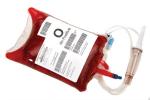|
This section contains 992 words (approx. 4 pages at 300 words per page) |

|
Blood is the fluid that circulates in the blood vessels of the body. Morphologically, it is a mesenchymatous tissue derived from the diffuse network of cells forming the embryonic mesoderm, that gives rise to blood and also blood vessels, the lymphatic system, and cells of the mononuclear phagocyte system. Blood cells (or hemocytes) are suspended in a fluid matrix, known as plasma. The chief non-cellular components of plasma are proteins (albumin and globulins), anions (mainly chloride and bicarbonate) and cations (mainly sodium, with smaller concentrations of potassium, calcium and magnesium).
Functionally, blood separates and protects the cells of the body from the external environment. The composition of blood and its acid-base balance are regulated within certain narrow limits, thereby ensuring that the body's internal environment is constant. As part of its function, blood mediates the exchange of material between the environment and the cells and tissues of the...
|
This section contains 992 words (approx. 4 pages at 300 words per page) |

|


